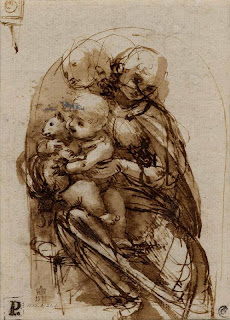 National Novel Writing Month ended last Friday, with a total of 1187,931,929 words being written worldwide. All over the internet people are blogging about their experiences. My friend Kathleen Bolton at Writer Unboxed is happy she created some good prose even though she didn’t reach the 50,000 word NaNoWriMo goal. I’m happy too but in a different way. I did reach 50K though I’ll admit most of the scenes will require heavy duty revisions.
National Novel Writing Month ended last Friday, with a total of 1187,931,929 words being written worldwide. All over the internet people are blogging about their experiences. My friend Kathleen Bolton at Writer Unboxed is happy she created some good prose even though she didn’t reach the 50,000 word NaNoWriMo goal. I’m happy too but in a different way. I did reach 50K though I’ll admit most of the scenes will require heavy duty revisions.
Critics of the NaNoWriMo process question the point in writing madly to meet a quota. For me, it’s not a matter of quantity versus quality because during my early drafts my goal isn’t really to generate words so much as ideas. Quantitative goals keep me tackling scene after scene, concentrating on characterization and plotting and leaving stylistic issues for the rewrites.
I’ve been known to call my rough drafts primordial ooze. But they can also be likened to an artist’s sketches. Consider this Da Vinci study for “Virgin and Child with Cat”. Note the different positioning of head, limbs. The fluidity, the testing of ideas. OK, maybe it’s pretentious to compare my scribblings to efforts of creative minds like Da Vinci. But I find it reassuring that their work went through messy phases–though sketches like this (unlike my rough drafts) have a beauty of their own.
 Another artistic genius whose process fascinates me is Beethoven. A few years ago a librarian found the lost manuscript for a piano version of Beethoven’s Grosse Fugue (the last movement in the string quartet in B flat major, Op 130). According to article in the Guardian the manuscript “shows the extent of Beethoven’s reworkings and includes deletions, corrections and deep erasures – occasionally the paper is rubbed right through leaving small holes – smudged alterations and several pages pasted over the original or affixed with sealing wax.” It even looks like there’s blood on the page–don’t we all know that feeling?! (The articles says it’s red crayon.)
Another artistic genius whose process fascinates me is Beethoven. A few years ago a librarian found the lost manuscript for a piano version of Beethoven’s Grosse Fugue (the last movement in the string quartet in B flat major, Op 130). According to article in the Guardian the manuscript “shows the extent of Beethoven’s reworkings and includes deletions, corrections and deep erasures – occasionally the paper is rubbed right through leaving small holes – smudged alterations and several pages pasted over the original or affixed with sealing wax.” It even looks like there’s blood on the page–don’t we all know that feeling?! (The articles says it’s red crayon.)
The Grosse Fugue is one of Beethoven’s most innovative compositions, challenging to performers and listeners. Originally given a cool reception, it’s still the sort of piece that requires concentration and reveals more each time one hears it. I took my budding violinist to a performance by the Guarneri Quartet and we were both blown away.
I personally find it reassuring to know that even great creative works sometimes go through an ugly birthing process. But I suppose it could be scary as well. What do you think? Or would you rather enjoy the final result without knowing about the messy bits? Are there any artists (of any sort) whose methods or process inspire you?
Elena
www.elenagreene.com

Red crayon???
Nah, we all know it’s really blood. 🙂
Cara
Elena, if I have to think about how a work was created, especially a novel, then the novelist hasn’t done her job. The trick should be to make us forget all about the fact that some author sweated blood creating this. We’re supposed to be swept away into a different world.
I often prefer sketches to finished paintings. They have more life to them.
Doesn’t translate to novels, though!
I have to agree with the Divine Ms. G. The novels I love best are those that appear to be seamless and effortless on the part of the author. Of course now that I am trying this writing thing myself I know that is the farthest thing from the truth. I just hope I eventually learn how to create that world-sweeping style!! As a student at the Mozarteum in Salzburg, which is a depository for almost all known Mozart manuscripts, I was privileged to view almost everything in the library at some point. There was a rotating schedule of which works would be on display for the use of the students and even then they were under glass. The most amazing thing about them? No changes! None! It was as if he was taking dictation from God.
Elena, ooh! You saw the Guarneri in person. How very cool!
Mozart was known to have very clean copy, even the first drafts.
Diane, yes! You always know just how to phrase what I’m thinking. The last choral bits of Beethoven’s Ninth…….Never fails to sweep me away and make me weep.
Just read Pam’s comment above. I had no idea that “clean copy” meant that Mozart made no changes. WOW!
In some ways it’s scarier to contemplate Mozart’s process. It makes me wonder why I can’t have that same sort of direct connection to the divine. I’ve done The Artist’s Way and have had moments of that connection but never so consistently.
OTOH the messy bits could just have been going on in Mozart’s head before he wrote anything down.
Diane, I totally agree that the final result should not look like a bloody mess. When I finish a book I’m always amazed that scenes I rewrote umpteen times don’t stick out from the ones that came more easily. It’s just comforting to me to know that others struggle too!
Doglady, there was a terrific exhibit at the Smithsonian a few years ago on pianos and composers, and I found it thrilling to see the mss. Both Mozart’s and Chopin’s were pristine whereas Beethoven’s were as messy as the example Elena gave.
I’m still torn over the NaNo thing. I tell myself that even if I chuck what I wrote, I’m still closer to finishing than I was before I started. Glass half full, etc.
Really cool sketch, Elena!
Whoops that was me, Kathleen Bolton, on the previous comment. My original identity has been deleted from Blogger, and I haven’t re-freshed since.
Nah, that’s okay. 🙂 I never thought about it for books, but sure have for tv shows/movies — and some behind the scenes info is just simply too much. I look at I Love Lucy, and I really don’t want to know how they didn’t get along behind the scenes or whatnot. It takes away from watching the finished product. Bet the same thing is true for something written. 🙂
Lois
Coincidental, this talk of Beethoven’s Ninth, because I literally just got home from a performance of it! It Must Be Fate. Truly, it is an amazing composition.
I think that one can appreciate a work of art on different levels. There is the immediate level, in which one reads a novel, or listents to a piece of music, or views a painting, where one wants to be plunged into a seamless whole. But there is also the level of analysis, where insight into the artist’s craft can give further appreciation of the end result.
From that point of view, Beethoven’s process–endless tinkering and reworking of ideas–is more helpful than Mozart’s. I mean, it’s impressive that Mozart could create pieces entirely in his head and then write them down, but how on earth can one emulate that? 🙂
Interestingly, much the same kind of thing happens in scientific research–the research process is often very disorderly, with many false starts, wrong turns, and dead ends. But when you write up a result, you always give a clear, logical path from the beginning to the end, which usually resembles what you actually did almost not at all. You can learn about science by reading papers and monographs, but you can’t learn to do science that way. I think most forms of creative work are like that.
Todd-who-will-stop-nattering-on-now